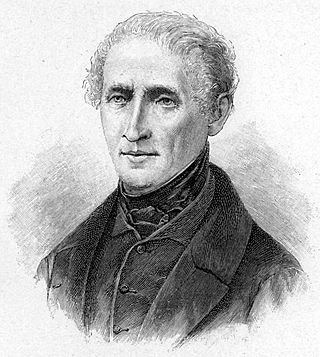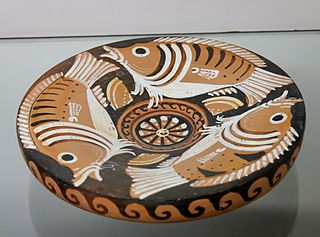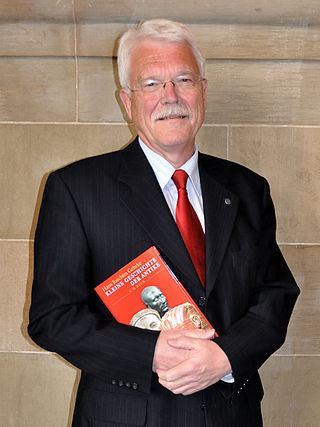
Joseph Freiherr von Eichendorff was a German poet, novelist, playwright, literary critic, translator, and anthologist. Eichendorff was one of the major writers and critics of Romanticism. Ever since their publication and up to the present day, some of his works have been very popular in German-speaking Europe.

Red-figure pottery is a style of ancient Greek pottery in which the background of the pottery is painted black while the figures and details are left in the natural red or orange color of the clay.

A fish plate is a Greek pottery vessel used by western, Hellenistic Greeks during the fourth century BC. Although invented in fifth-century BC Athens, most of the corpus of surviving painted fish plates originate in Southern Italy, where fourth-century BC Greek settlers, called "Italiotes," manufactured them.

Brygos was an ancient Greek potter, active in Athens between 490 and 470 BC. He is known as a producer of excellent drinking cups. About 200 of his pieces are known. The workshop of Brygos employed a red-figure vase painter who is conventionally called the Brygos Painter. The Brygos Painter is one of the most famous vase painters of his time. His work is characterised by its high quality and realistic depictions. The workshop of Brygos also employed the Briseis Painter, among others.

Joachim Latacz is a German classical philologist.

The Virgin Annunciate is a painting by the Italian Renaissance artist Antonello da Messina, housed in the Palazzo Abatellis, Palermo, region of Sicily, Italy. Probably painted in Sicily in 1476, it shows Mary interrupted at her reading by the Angel of the Annunciation. It is painted in oil on panel, a technique introduced to Italy by its artist, who had learned it from North European artists such as Petrus Christus - by thus abandoning tempera technique he was able to produce the finely-detailed works typical of him.

The Master of Arguis was an Aragonese artist active in the first half of the 15th century. Stylistically, his work is related to that of Juan de Levi and Bonanat Zaortiga, and is derived from the tradition of the International Gothic in Aragon. His name is derived from a retable of Saint Michael dating to about 1440, now in the Museo del Prado in Madrid; this was once the main altarpiece of the church of Arguis. The painting depicts the victory of Michael over the Antichrist, and focuses primarily on the latter figure, pierced with a lance. Included in the scene are various secular figures, including kings and noblemen, as well as religious figures. At the bottom of the image may be seen a papal tiara and sceptre, symbols of the power the Antichrist claims to wield as the new Messiah. Two other paintings, both dedicated to Saint Anne, are attributed to the Master; one is in Barcelona, while the other, a small triptych, is in the collegiate church of Alquezar.

Rudolf Simek is an Austrian philologist and religious studies scholar who is Professor and Chair of Ancient German and Nordic Studies at the University of Bonn. Simek specializes in Germanic studies, and is the author of several notable works on Germanic religion and mythology, Germanic peoples, Vikings, Old Norse literature, and the culture of Medieval Europe.
Christian Habicht was a German historian of ancient Greece and an epigrapher in Ancient Greek.
Rudolf Carl Franz Otto Pfeiffer was a German classical philologist. He is known today primarily for his landmark, two-volume edition of Callimachus and the two volumes of his History of Classical Scholarship, in addition to numerous articles and lectures related to these projects and to the fragmentary satyr plays of Aeschylus and Sophocles.

Hans-Joachim Gehrke, in full Hans-Joachim Günter Adolf Gehrke, is a German historian of ancient and classical antiquity. He was president of the German Archaeological Institute from 2008 to 2011.

Eye-cup is the term describing a specific cup type in ancient Greek pottery, distinguished by pairs of eyes painted on the external surface.

Three-phase firing or iron reduction technique is a firing technique used in ancient Greek pottery production, specifically for painted vases. Already vessels from the Bronze Age feature the colouring typical of the technique, with yellow, orange or red clay and brown or red decoration. By the 7th century BC, the process was perfected in mainland Greece enabling the production of extremely shiny black-slipped surfaces, which led to the development of the black-figure and red-figure techniques, which dominated Greek vase painting until about 300 BC.
Wolfram Hoepfner is a German classicist, archaeologist, architectural historian, and Professor of Ancient Architectural History, at the Free University of Berlin.
Hans Rupprecht Goette is a German classical archaeologist.
Wolfgang Müller-Wiener was a German architecture historian, archaeologist and Byzantinist.

Melian Pithamphorae or Melian Amphorae are names for a type of large belly-handled amphorae, which were produced in the Archaic period in the Cyclades. On account of their shape and painted decoration in the Orientalising style, they are among the most famous Greek vases. The amphorae are dated to the seventh and early sixth centuries BC; the last of them was made in the 580s. They were used as grave markers with the same function as the later grave statues and reliefs and were dedicated as cult objects in sanctuaries. With the increasing importance of sculpture in these roles, the production of these vases came to an end.
Georg Busolt was a German historian of Classical history.

The Antenor Kore is a Late Archaic statue of a girl (Kore) made of Parian marble, which was created around 530/20 BC.

Ingeborg Weber-Kellermann was a German folklorist, anthropologist and ethnologist. She was an academic teacher, from 1946 at the German Academy of Sciences at Berlin in East Berlin and from 1961 at the University of Marburg.













